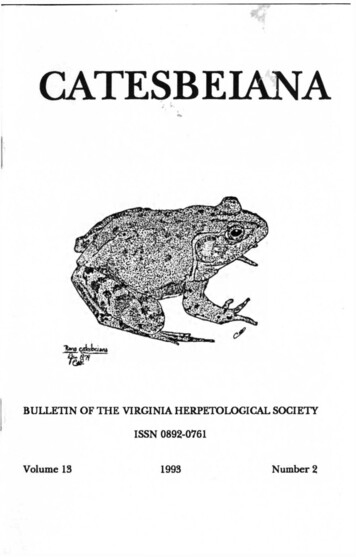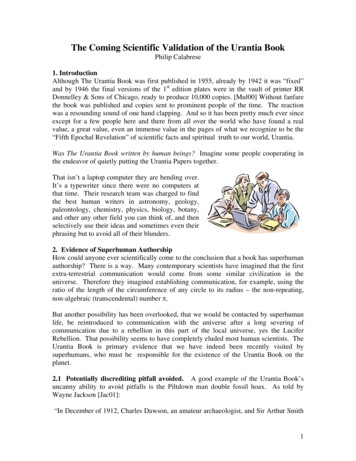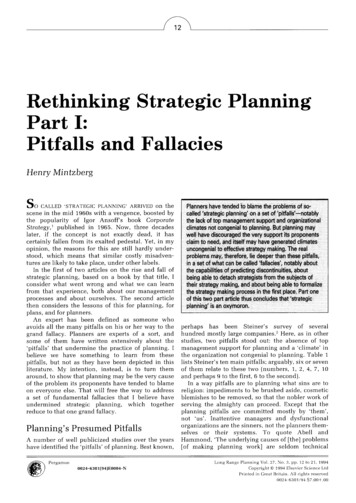
Transcription
Herpetological Monitoring Using a Pitfall TrappingDesign in Southern CaliforniaChapter 5 ofSection A, Biological ScienceBook 2, Collection of Environmental DataTechniques and Methods 2–A5U.S. Department of the InteriorU.S. Geological Survey
Cover: Pitfall trap arrays have been used in southern California to document reptile and amphibian species. Photograh taken byU.S. Geological Survey, date unknown.
Herpetological Monitoring Using a PitfallTrapping Design in Southern CaliforniaBy Robert Fisher, Drew Stokes, Carlton Rochester, Cheryl Brehme, and StacieHathaway, U.S. Geological Survey; and Ted Case, University of CaliforniaChapter 5 ofSection A, Biological ScienceBook 2, Collection of Environmental DataTechniques and Methods 2–A5U.S. Department of the InteriorU.S. Geological Survey
U.S. Department of the InteriorDIRK KEMPTHORNE, SecretaryU.S. Geological SurveyMark D. Myers, DirectorU.S. Geological Survey, Reston, Virginia: 2008For product and ordering information:World Wide Web: http://www.usgs.gov/pubprodTelephone: 1-888-ASK-USGSFor more information on the USGS—the Federal source for science about the Earth, its natural and living resources,natural hazards, and the environment:World Wide Web: http://www.usgs.govTelephone: 1-888-ASK-USGSAny use of trade, product, or firm names is for descriptive purposes only and does not imply endorsement by the U.S.Government.Although this report is in the public domain, permission must be secured from the individual copyright owners toreproduce any copyrighted materials contained within this report.Suggested citation:Fisher, Robert; Stokes, Drew; Rochester, Carlton; Brehme, Cheryl; Hathaway, Stacie; and Case,Ted,2008,Herpetological monitoring using a pitfall trapping design in southern California: U.S. Geological SurveyTechniques and Methods 2-A5, 44 p.
iiiContentsAbstract.11.0 Introduction.12.0 Background and Justification.13.0 Array Design .23.1 Trap Labeling/ Numbering.44.0 Array Materials and Trap Construction.44.1 Drift Fencing.44.2 Pitfall Traps.44.2.1 Pitfall Trap Cover.44.3 Equipment within Pitfall Traps.54.4 Funnel Traps .54.4.1 Funnel Traps with Pitfall Trap Retreats .104.5 Weather Stations.125.0 Array Installation .135.1 Personnel, Equipment, and Logistics.135.2 Installation Instructions.135.2.1 Pitfall Arrays.135.2.2 Weather Stations.146.0 Array Operation . .146.1 Survey Scheduling.146.2 Personnel, Equipment, and Logistics.156.2.1 Safety Precautions.166.3 Survey Methods (Checking Traps).166.4 Field Identification .166.5 Processing Specimens.166.5.1 Processing Lizards, Turtles, Frogs, Toads, Salamanders, and Newts(Limbed Animals).176.5.2 Processing Snakes and Other Limbless Specimens.206.5.3 Incidental Captures and Observations.226.6 Vegetation Surveys.227.0 Survey Data Management.247.1 Data Collection and Entry . .247.1.1 Pitfall Capture Data.247.1.2 Megafauna Data.267.1.3 Weather Data.267.2 Quality Assurance/Quality Control.297.3 Data Organization and Summarization.297.4 Data Analysis.368.0 Acknowledgments.369.0 References Cited.39Appendix 1. Materials and supplies needed to build, maintain, and sample a pitfalltrapping array. .43Appendix 2. Species codes and abbreviatoins. .44
ivFiguresFigure 1.Figure 2.Figure 3.Figure 4.Figure 5.Figure 6.Figure 7.Figure 8.Figure 9.Figure 10.Figure 11.Figure 12.Figure 13.Figure 14.Figure 15.Figure 16.Figure 17.Figure 18.Figure 19.Figure 20.Figure 21.Figure 22.Pitfall array (A) overhead view and (B) side view design Pitfall trap design diagram Assembly of funnel (snake) trap body diagram Preparing hardware cloth for funnel (snake) trap end cone design Assembly of funnel (snake) trap and cone diagram Completed funnel (snake) trap assembly diagram Funnel (snake) trap shade cover and position Desert funnel (snake) trap with pitfall trap retreat Desert funnel (snake) trap with pitfall trap retreat Front view (A) and top view (B) of weather station The cumulative number of species detected by pitfall array surveys forthree study sites in San Diego County, California Measure each animal from snout to vent Numbering reptile toe clips Numbering amphibian toe clips Numbering snake scale clips Paper data form for recording animal captures Handheld computer form for recording animal capture data Paper data form for recording megafauna captures Paper data form for recording weather conditions Handheld computer data form for recording weather conditions Tabular and graphical displays of temperature patterns for a sampling period Example site map. 3567899101112Reptile and amphibian toe-clip numbers Snake scale-clip numbers Vegetation data spreadsheet. Reptile and amphibian data spreadsheet Small mammal data spreadsheet Site location file Summary of small mammal species captured at each pitfall array Summary of reptile and amphibian species captured at each pitfall array Capture rate Average capture rate table Table 1.Table 2.Table 3.Table 4.Table 5.Table 6.Table 7.Table 8.Table 9.Table 10.
vConversion FactorsInch/Pound to SIMultiplyByTo obtainLengthinch (in.)2.54centimeter (cm)foot (ft)0.3048meter (m)mile (mi)1.609kilometer (km)Volumegallon (gal)3.785pound, avoirdupois (lb)0.4536liter (L)Masskilogram (kg)SI to Inch/PoundMultiplyByTo obtainLengthcentimeter (cm)0.3937inch (in.)millimeter (mm)0.03937inch (in.)meter (m)3.281foot (ft)Volumeliter (L)0.2642gallon (gal)Massgram (g)0.03527ounce, avoirdupois (oz)kilogram (kg)2.205pound, avoirdupois (lb)Temperature in degrees Celsius ( C) may be converted to degrees Fahrenheit ( F) as follows: F (1.8 C) 32DatumHorizontal coordinate information is referenced to the North American Datum of 1983 (NAD 83).
viThis page intentionally left blank.
Herpetological Monitoring Using a Pitfall TrappingDesign in Southern CaliforniaBy Robert Fisher1, Drew Stokes1, Carlton Rochester1, Cheryl Brehme1, Stacie Hathaway1, and Ted Case2AbstractThe steps necessary to conduct a pitfall trapping surveyfor small terrestrial vertebrates are presented. Descriptionsof the materials needed and the methods to build trappingequipment from raw materials are discussed. Recommendeddata collection techniques are given along with suggested datafields. Animal specimen processing procedures, including toeand scale-clipping, are described for lizards, snakes, frogs, andsalamanders. Methods are presented for conducting vegetationsurveys that can be used to classify the environment associatedwith each pitfall trap array. Techniques for data storage andpresentation are given based on commonly use computerapplications. As with any study, much consideration should begiven to the study design and methods before beginning anydata collection effort.1.0 IntroductionDue to its mild climate, complex topography, and richgeologic and biogeographic history, southern Californiasupports a high diversity of reptiles and amphibians (Stebbins,1985; Fisher and Case, 1997). Most species can be ratherinconspicuous, making them difficult to survey at thecommunity level. Because of this, much of their ecology andhabitat affinities are not well known. For researchers andland managers to be able to answer ecological questions andaddress management needs of the local herpetofauna, it isnecessary to identify a cost-effective field survey techniquethat detects all or most of the species in a given area withminimal sampling bias. The technique that is the mostaccommodating to these needs is drift fences with pitfall andfunnel traps.Drift fences are barriers that act to intercept and guidesmall terrestrial animals into pitfall or funnel traps placedalong the fences. Pitfall traps are open containers that areburied in the ground such that the tops of the containers arelevel with the ground. Small terrestrial animals fall into the12U.S. Geological Survey.Department of Biology, University of California at San Diego.containers as they move across the ground. Funnel traps areelongated traps that have funnels at one or both ends that allowanimals to pass easily into them through the large end of thefunnels. The animals, once inside the traps, have difficultyfinding their way out through the small end of the funnels andare trapped.Since initiation of large-scale pitfall trapping in coastalsouthern California in 1995, this technique has proven tobe effective at sampling a high diversity of reptiles andamphibians, invertebrates and small mammals (Fisher andCase, U.S. Geological Survey, written commun., 2000;Case and Fisher, 2001; Laakonen and others, 2001). Thisreport describes, in detail, all of the elements of our pitfalltrapping protocol with specific descriptions of how to processreptiles (lizards, snakes, and turtles) and amphibians (frogs,toads, salamanders, and newts). The purpose of this reportis to describe trap array design, materials used, samplingschedules, personnel needs, equipment requirements, logisticalconsiderations, trap installation and operating procedures,safety precautions, specimen identification and processing, sitecharacterization (weather and vegetation), data collection andentry, and data management and analysis.2.0 Background and JustificationMonitoring biological diversity is a current priority forresearchers, land managers, and resource managers. It isimportant to have sampling and monitoring techniques that arecomprehensive, cost effective, and standardized (Dodd, 1994).Sampling reptiles and amphibians can be difficultbecause of their size, behavior, and cryptic coloring. Tomeet this task, numerous techniques have been employed byresearchers. Singly or in combination, these methods includetime-constrained searches, surveys of wood debris and coverboards, quadrate searches, road “cruising”, pitfall trapping,and funnel trapping (Scott, 1982; Heyer and others,1994).The latter techniques may be used in combination with driftfencing. Comparison studies of different sampling techniqueshave revealed that each technique has its own advantages,disadvantages, and set of sampling biases (Campbell and
2 Herpetological Monitoring Using a Pitfall Trapping Design in Southern CaliforniaChristman, 1982; Vogt and Hine, 1982; Corn and Bury, 1990;Rice and others, 1994; Fair and Henke, 1997; Jorgensen andothers, 1998; Ryan and others, 2002). In order to directlycompare data collected over multiple sites or times, it isimportant to use a standardized sampling method. Thismethod should minimize the amount of observer bias whilemaximizing the number of species documented. Timeconstrained searches, quadrat searches, and road cruising mayintroduce a significant amount of bias due to the differentskill levels of observers. A technique that has been identifiedas being the most effective for trapping a wide variety ofspecies with the least amount of observer bias in varioushabitats of southern California is the use of drift fences with acombination of pitfall and funnel traps (Case and Fisher, 2001;Ryan and others, 2002). In order to validate the effectivenessof the pitfall trapping technique, Case and Fisher (2001)compared results with several other survey techniques. Atthe same sites that pitfall traps were operated, professionalherpetologists conducted timed walking transects, timedvisual surveys of search plots, high intensity herpetologicalsearching, and passive observing surveys. None of thesetechniques yielded results as substantial as the pitfall trappingdesign for determining diversity or relative abundance of thelocal herpetofauna (Case and Fisher, 2001).Pitfall traps, funnel traps, and drift fencing have beenused to trap herpetofauna since the 1940s. Early studiestypically used traps alone or in simple linear fence arraysto collect and document herpetofauna (Imler, 1945; Fitch,1951; Banta, 1957; Banta, 1962; Medica, 1971). The shapeof the trapping array has since been adapted to meet specifichabitat types and study objectives. Traditional fences withlarge pitfall traps are effective for sampling squamate reptiles(Imler, 1945; Gloyd, 1947; Woodbury, 1951, 1953; Nelson andGibbons, 1972; Semlitsch and others, 1981; Enge, 2001; Ryanand others, 2002). Fences made of various materials with orwithout pitfall traps are effective for sampling turtles (Bennettand others, 1970; Gibbons,1970; Wygoda, 1979; Burke andothers, 1998). Funnel traps placed alongside drift fences haveproven effective at capturing amphibians and reptiles (Enge,2001). In order to study population and community dynamicsaround ponds and ephemeral aquatic habitats, fenced arrayshave been modified to encircle the water, thus catching allincoming and outgoing species (Storm and Pimental, 1954;Gibbons and Bennett, 1974; Dodd and Scott,1994). Theeffectiveness of terrestrial arrays has been increased bychanging the shape from a linear array to an “X” or “Y” shapewith trap arms protruding from a center pitfall trap (Campbelland Christman, 1982).In addition to collecting and documenting herpetofauna,these methods have been used for studies of habitat use(Bostic, 1965; Loredo and others, 1996) and populationdynamics of individual species (Pearson, 1955; Parker, 1972;Fisher and Shaffer, 1996) and communities (Storm andPimental, 1954; Gibbons and Bennett, 1974; Dodd, 1992).More recently, the scope of these studies has increased toaddress current ecological issues. Arrays have been replicatedover multiple sites to look at variation within and betweenmultiple habitats (DeGraaf and Rudis, 1990) and to study theeffects of human induced impacts on the relative abundanceand diversity of herpetofauna. These include effects of grazing(Jones, 1981), forestry practices (Rudolph and Dickson, 1990),mining (Ireland and others, 1994), water supplementation ofdesert habitats (Burkett and Thompson, 1994), and habitatfragmentation (McCoy and Mushinsky, 1994).To date, many studies are limited to use of one typeof trap, a short time frame, and (or) are conducted over alocalized geographical region. We have used a standardizedarray of pitfall traps, funnel traps, and drift fencing toperform long-term research over a wide geographic areawith replicates within and between site localities, habitats,and environments (Fisher and Case, 2000; Fisher and Case,U.S. Geological Survey, written commun., 2000; Rochesterand others, U.S. Geological Survey, written commun.,2001). The large scope of the trapping effort over southernCalifornia has enabled us to evaluate not only the effect oflocal landscape features on herpetofauna assemblages, butalso the effects of larger area geographical variables such aslatitude, altitude, and climate (Fisher and Case, 2000; Fisherand Case, U.S. Geological Survey, written commun., 2000).We have used the data to study autecology of sensitive species,effects of habitat fragmentation and introduced species onnative wildlife, regional patterns of herpetofaunal diversity,and historic versus current species distributions (Case andFisher, 2001; Laakkonen and others, 2001; Fisher and others,2002). By collecting tissue samples from animals capturedin the traps, we have enabled researchers to study phylogenyand population genetics of individual species (Maldonadoand others, 2001; Jockusch and Wake, 2002; Richmond andReeder, 2002; and Mahoney and others, 2003). The purpose ofthis report is to provide valuable data for both the theoreticaland applied sciences as well as for conservation planning.3.0 Array DesignArray designs can be variable. Compared with fourarmed arrays, three-armed arrays yield comparable results,(Heyer and others, 1994), use less material, and take less timeto construct. Our array design consists of three 15-m armsof drift fence with seven pitfall traps and three funnel traps(fig. 1). One pitfall trap is placed in the center of the array witheach of the three arms of drift fence extending outward fromthe center trap. The angle formed by the array arms around thecenter trap should be approximately 120 degrees. Pitfall trapsare placed in the middle and at the end of each arm of fencing.One funnel trap is placed along each arm approximatelyhalfway between the middle and end pitfall traps on the rightside of each arm when looking from the center trap toward theend trap. The funnel traps are placed consistently on the sameside of the fence at an array to ensure that funnel trappingresults are comparable among arrays.
3.0 Array Design 3A.Arm 1Arm 25-2A5-ST-15-1APitfall Trap5-2B5-ST-25-1B5-CDrift Fence5-3B5-ST-3Funnel Trap5-3AArm 3B.Drift FenceFunnel TrapPitfall Trap15 metersFigure 1. Pitfall array (A) overhead view and (B) side view design.
4 Herpetological Monitoring Using a Pitfall Trapping Design in Southern California3.1 Trap Labeling/ NumberingFor identification purposes, each array at a given studysite is assigned a number. Each array arm is assigned a number1, 2, or 3 in a clockwise direction beginning with the armarbitrarily designated as arm number 1 (usually the arm firstencountered on the trail is assigned the number 1). The pitfallcontainers are labeled A, B, and C for outer, middle, andcenter buckets, respectively. All of the traps making up anarray are first identified by the number of the array followedby the number of the arm along which the container lies. Forexample, the middle container at array five of arm three wouldbe identified as 5-3B. The center container of array five wouldbe identified as simply 5-C. The funnel traps, also called“snake traps” or “ST”, are identified by the arm number alongwhich they lie, 1–3. For example, the funnel trap located alongarm two of array five would be identified as 5-ST2 (fig. 1).4.0 Array Materials and TrapConstructionBelow is a complete description of materials neededfor the pitfall array design and instructions for makingindividual traps. Measures are presented in metric units withthe exception of materials commonly available in StandardEnglish units. Background information on traps and materialsis presented also. A complete supply list for array constructionand operation is provided in appendix 1.4.1 Drift FencingA variety of different materials can serve as effectivedrift fencing and should be chosen to suit the substrate(s)and weather conditions within the study area. For instance,a porous material should be used in areas with high winds toprevent winds from tearing out fences. Other materials thathave been used in various studies include clear roll plastic,silt fencing, wooden boards with bronze window screen,aluminum flashing, hardware cloth, and galvanized metal(Milstead, 1953; Storm and Pimental, 1954; Pearson, 1955;Gibbons and Semlitsch, 1981; Campbell and Christman, 1982;Bury and Corn, 1987; Murphy, 1993; Enge, 1997; Jorgensenand others, 1998; Zug and others, 2001). We use 30-cm tallnylon shade cloth. The length of drift fence is 15 m per arrayarm (7.5 m between each pitfall trap). Wooden stakes(1- 2- 24-in.) are used to secure the drift fence upright.The drift fence is secured to the stakes by using heavy-dutystaples and a heavy-duty staple gun. Ten to 15 stakes are usedper 15-m arm of fencing. See installation section in this reportfor procedures. Gibbons and Semlitsch (1981) discussed theadvantages and limitations of the drift fence technique andconsidered aluminum flashing to be superior to other fencingmaterials in their area because it is more difficult for animalsto bypass and it does not deteriorate or rust. We use the shadecloth in rocky areas with many surface irregularities.4.2 Pitfall TrapsVarious containers have been used as pitfall traps such as19-L (5-gal) plastic buckets, coffee cans, metal buckets, “lard”cans, local pottery water containers, and 208-L (55-gal) drums(Pearson, 1955; Banta, 1957, 1962; Gibbons and Bennet,1974; Gibbons and Semlitsch, 1981; Campbell and Christman,1982; Vogt and Hine, 1982; Yunger and others,1992; Corn,1994; and Zug and others, 2001). Larger containers generallycapture more animals (Vogt and Hine, 1982), while smaller(more shallow) containers increase the likelihood for escape.The double-pit systems may aid in trapping larger reptiles(Friend, 1984), although smaller containers may be usefulif the target is smaller and there is no need to capture thelarger animals (Shoop, 1965; Gill, 1978; Douglas, 1979).Additionally, fitting a plastic collar to the top of pitfall trapsmay prevent some animals from escaping the container (Vogtand Hine, 1982).Containers should be buried such that the rim is flushwith the ground. The containers should have small drain holesin the bottom to minimize flooding during rain events whiletraps are open. We typically use white plastic 19-L (5-gal)buckets. At desert sites, we use 23-L (6-gal) buckets becausethey are deeper and provide increased insulation from heat.Crawford and Kurta (2000) found that black plastic bucketstrapped frogs and shrews more effectively than did whiteplastic buckets. However, black buckets may experience highinternal temperatures when exposed to intense sunlight forlong periods. This could result in damage to the containers andincreased trap mortality. Dodd (1992) used slanting pegboardsto partially shade the black buckets in Florida.4.2.1 Pitfall Trap CoverAll pitfall traps should have some form of top cover whenopen to shield animals from the elements. We use an invertedlid design set on top of the trap with wooden spacers (fig. 2).This design prevents most litter, sunlight, and precipitationfrom entering the open bucket while allowing sufficient spacefor small animals to enter.To construct the top cover, cut three 6.4-cm-long piecesof 2- 2-in. construction-grade wood at a 35-degree angle.Attach these, facing outward, around the top of the bucket lidusing 1.25-in. drywall screws with SAE #10 washers. Makevertical cuts approximately every 15 cm around the outerperimeter of the lid. This will allow easier opening and closingof the traps. When the traps are open, the lid is turned overwith the spacers resting on top of the bucket (fig. 2). Animalsand wind occasionally remove the container lids while in theopen position. When necessary, bungee cords may be used tokeep the lids on. To attach the bungee cords to the pitfall traps,drill three holes, with diameters similar to the bungee cords, in
4.0 Array Materials and Trap Construction 5Drift FenceBucket Lid withWooden LegsWoodenStakesSoilSurfaceBuried DriftFenceSoil5-gal PitfallBucketFigure 2.Pitfall trap design diagram (gal, gallon).the sides of the bucket. The holes should be evenly spaced andapproximately 8 cm down the container sides. Next, cut three12-in. bungee cords in half. Feed the cord ends through theholes from the inside of the container and tie a knot at the endof the cord outside the container. Attach the cords by pullingout the hook ends and fastening onto the lid while it rests onthe wooden feet. There should be enough tension in the cordthat it takes considerable force to remove the lid from itsresting position without unhooking the bungee cord. Woodenboards that attach to the pitfall containers using bolts and eyesockets may also be used to keep container lids on while theyare being sampled (Fellers and Pratt, 2002).4.3 Equipment within Pitfall TrapsCover should be provided within the pitfall traps forcaptured animals. We use two segments of differently sizedPVC pipes, a 6-in. long piece of 1.5-in. diameter pipe andan 8-in. long piece of 1-in. diameter pipe. Some form ofinsulation such as synthetic batting or foam material shouldbe provided in the PVC pipes if small mammals are likely tobe captured. We place a section of closed foam pipe insulationwithin the 1.5-in. diameter piece of pipe.Placing a wet sponge in the pitfall trap is recommendedto help keep amphibians hydrated. The sponges should bewetted on a daily basis when traps are opened. The use ofsponges is discontinued in southern California during the drymonths, as they usually attract ants. A large number of antscan kill or seriously injure small vertebrates in the traps.4.4 Funnel TrapsA variety of materials can be used to make funnel trapsbut 0.125-, 0.25-, or 0.33-in.-mesh hardware cloth has beenthe material of choice in herpetological studies (Imler, 1945;Gloyd, 1947; Fitch, 1951; and Milstead, 1953). The trapsshould be sturdy yet lightweight. We used 0.25-in. hardwarecloth for the studies documented in this report.To construct the funnel traps, first cut 100-ft rolls of36-in. hardware cloth into 18-in. wide sections. For eachcylinder body, roll one 36- 18-in. section of hardware clothalong the 18-in. edge into a cylinder and fasten with hog-rings.Plastic zip-ties or cable ties can be used (fig. 3). Under fieldconditions, the metal hog-rings have a longer life than do theplastic zip-ties, which tend to last for only 1 year in southernCalifornia sun. The same hardware cloth is used to makethe funnel ends. To make funnel ends, cut a 24-in. diametercircle of hardware cloth into four equal sections (fig. 4). Eachpiece is rolled into a funnel shape and s
Book 2, Collection of Environmental Data. Cover: Pitfall trap arrays have been used in southern California to document reptile and amphibian species. Photograh taken by . Drift fences are barriers that act to intercept and guide : small terrestrial animals into pitfall or funnel traps placed along the fences. Pitfall traps are open containers .










